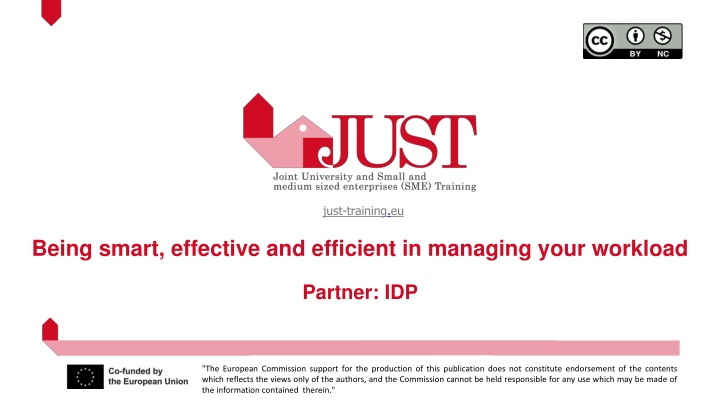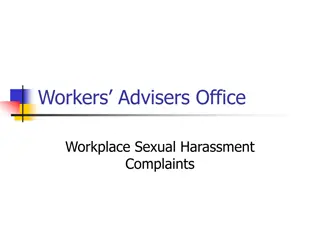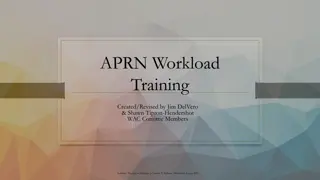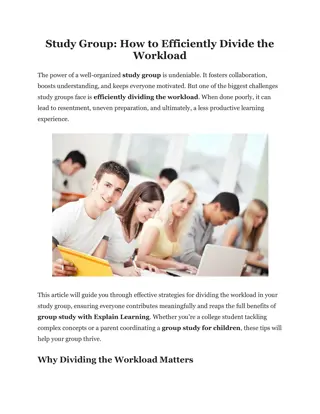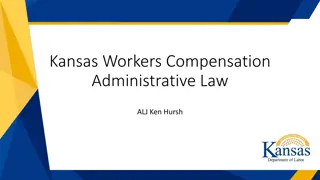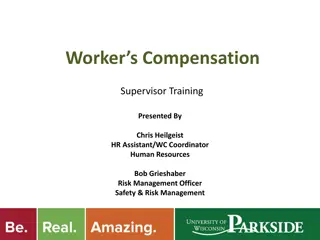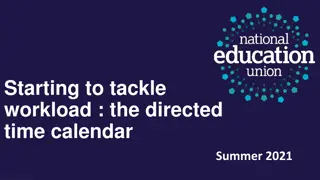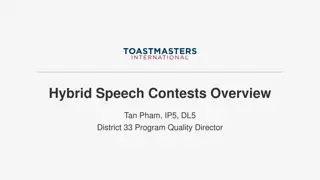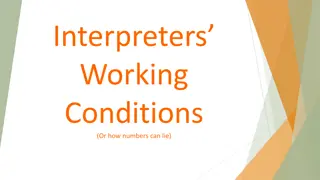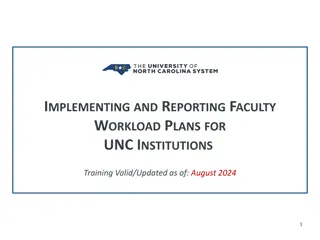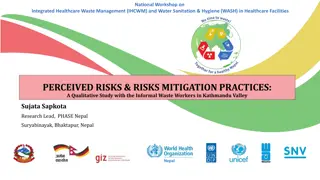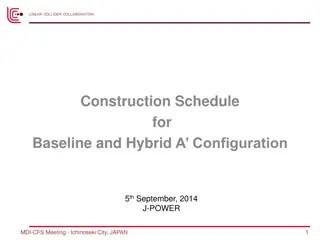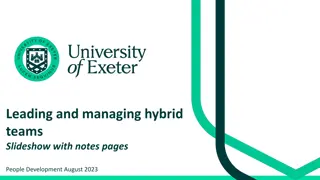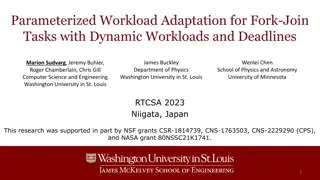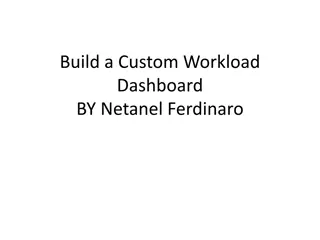Efficient Workload Management Techniques for Hybrid Workers
Learn how to be smart, effective, and efficient in managing your workload with the work-breakdown approach. Develop a better understanding of task prioritization and master effective strategies to perform under pressure. Discover valuable insights to balance your workload and prioritize tasks effectively. Take a step-by-step approach to overcome challenges and enhance your productivity in the workplace.
Download Presentation

Please find below an Image/Link to download the presentation.
The content on the website is provided AS IS for your information and personal use only. It may not be sold, licensed, or shared on other websites without obtaining consent from the author.If you encounter any issues during the download, it is possible that the publisher has removed the file from their server.
You are allowed to download the files provided on this website for personal or commercial use, subject to the condition that they are used lawfully. All files are the property of their respective owners.
The content on the website is provided AS IS for your information and personal use only. It may not be sold, licensed, or shared on other websites without obtaining consent from the author.
E N D
Presentation Transcript
just-training.eu Being smart, effective and efficient in managing your workload Partner: IDP "The European Commission support for the production of this publication does not constitute endorsement of the contents which reflects the views only of the authors, and the Commission cannot be held responsible for any use which may be made of the information contained therein."
Learning outcomes At the end of this module, you will: Be more efficient and more effective in managing your workload Better understand task prioritisation Master some hacks to perform under pressure "The European Commission support for the production of this publication does not constitute endorsement of the contents which reflects the views only of the authors, and the Commission cannot be held responsible for any use which may be made of the information contained therein."
Index The work-breakdown approach for hybrid workers Eating An Elephant One Bite At A Time The Input Output Outcome cycle to manage your work Performing under pressure How do you find balance when things get rough? Prioritising priorities: how to do it "The European Commission support for the production of this publication does not constitute endorsement of the contents which reflects the views only of the authors, and the Commission cannot be held responsible for any use which may be made of the information contained therein."
1. The work-breakdown approach for hybrid workers Eating An Elephant One Bite At A Time Eating an elephant one bite at a time is a notorious idiom from the South African theologian and bishop Desmond Tutu. The expression is frequently used in the business environment, and it refers to the opportunity of accomplishing something that seems too big to be dealt with until its done piece by piece, one step after the other. During your onboarding period and at the very early stage of your professional development, most of the time you will feel tired, under pressure, and overwhelmed by new tasks that accumulate faster than how you can process them. Be assured that this impression is mostly due to the lack from your side (for now) of robust, sound and reliable self-organisation techniques. In the next few slides, you will be introduced to some of these techniques that help in moving forward with agility and effectiveness. "The European Commission support for the production of this publication does not constitute endorsement of the contents which reflects the views only of the authors, and the Commission cannot be held responsible for any use which may be made of the information contained therein."
1. The work-breakdown approach for hybrid workers Plan to have a plan The very first trick to reduce this sense of pressure addresses the opportunity to schedule, plan and strategise your workload. In other words, you wish to start cutting the many pieces of the elephant. Once you start perceiving that too many things are adding up to your agenda, that is the moment in which you have to: 1 Take a deep breath and have a moment for yourself 2 Write down all the things that are pending from your side in the form of a to-do list Go through each of the points of your action list and break down a plan 3 Once things are in order, you will soon start realising how, indeed, things are reasonably manageable. "The European Commission support for the production of this publication does not constitute endorsement of the contents which reflects the views only of the authors, and the Commission cannot be held responsible for any use which may be made of the information contained therein."
Set work packages that lead you to more manageable workload 1. The work-breakdown approach for hybrid workers Measured in days Work Package Action 1 2 3 4 5 6 7 8 9 10 11 12 13 14 15 16 17 18 19 20 Activity 1.1 ___ Activity 1.2 ___ WORK PACKAGE 1 Activity 1.3 ___ Activity 1.4 ___ Activity 2.1 ___ WORK PACKAGE 2 Activity 2.2 ___ Activity 2.3 ___ Activity 3.1 ___ Activity 3.2 ___ Activity 3.3 ___ WORK PACKAGE 3 Activity 3.4 ___ Activity 3.5 ___ Activity 3.6 ___ Activity 4.1 ___ WORK PACKAGE 4 Activity 4.2 ___ Activity 4.3 ___ "The European Commission support for the production of this publication does not constitute endorsement of the contents which reflects the views only of the authors, and the Commission cannot be held responsible for any use which may be made of the information contained therein."
1. The work-breakdown approach for hybrid workers Set work packages that lead you to a more manageable workload Work Package WPs (work packages) include a set of activities (i.e., tasks) that lead you to the achievement of major results: the publication and delivery of an important report, the submission of an analysis, or whatever might be concretely expected from you. WORK PACKAGE 1 A whole WP (ex., WP3) might be represented, for instance, by the submission to the whole project team of a Project Management Plan (PMP). WORK PACKAGE 2 The draft and consolidation of the project management plan include indeed various sub-task and activities that lead you to its final completion. WORK PACKAGE 3 If you are requested to prepare such a document, do not conceive it as a whole task but rather as a system of integrated activities. WORK PACKAGE 4 "The European Commission support for the production of this publication does not constitute endorsement of the contents which reflects the views only of the authors, and the Commission cannot be held responsible for any use which may be made of the information contained therein."
1. The work-breakdown approach for hybrid workers Set work packages that lead you to a more manageable workload Going back to the example of the PMP, let s suppose that the preparation of this document can be formally broken down into six separate activities. Thinking of the JUST s PMP, we can identify them as follows: 1. Draft of an initial outline: consolidation of the table of content Action Activity 1.1 ___ Activity 1.2 ___ Activity 1.3 ___ Activity 1.4 ___ Activity 2.1 ___ 2. Initial validation of first two sections: Introduction to the project and expected outcomes Activity 2.2 ___ Activity 2.3 ___ 3. Detailed presentation of project results and milestones Activity 3.1 ___ Activity 3.2 ___ 4. Punctual and precise disclosure of financial management and budget control Activity 3.3 ___ Activity 3.4 ___ Activity 3.5 ___ 5. Arrangement and planning of monitoring and evaluation mechanisms for quality assurance Activity 3.6 ___ Activity 4.1 ___ 6. Presentation of STKH engagement strategies and PR plan Activity 4.2 ___ Activity 4.3 ___ "The European Commission support for the production of this publication does not constitute endorsement of the contents which reflects the views only of the authors, and the Commission cannot be held responsible for any use which may be made of the information contained therein."
1. The work-breakdown approach for hybrid workers Set work packages that lead you to a more manageable workload With that in mind, now you can finally visualize the concrete time that the achievements of this WP will absorb you and how tasks are spread over time i.e., when they are due by. Day 10 Day 11 Day 12 Day 13 Day 14 Day 15 Day 16 1. Draft of an initial outline: consolidation of the table of content 2. Initial validation of first two sections: Introduction to the project and expected outcomes Save for yourself some margins of flexibility: it is a good recommendations to overestimate on purpose the time needed for a specific action if case any urgency requires from you to put aside what you re doing and focus on something else. 3. Detailed presentation of project results and milestones 4. Punctual and precise disclosure of financial management and budget control 5. Arrangement and planning of monitoring and evaluation mechanisms for quality assurance Try to stick to the plan but be ready for frequent adjustments. 6. Presentation of STKH engagement strategies and PR plan "The European Commission support for the production of this publication does not constitute endorsement of the contents which reflects the views only of the authors, and the Commission cannot be held responsible for any use which may be made of the information contained therein."
1. The work-breakdown approach for hybrid workers Meeting the deadlines that you set for yourself over a medium-long period implies from your side great discipline and organisation starting from the very way you plan your daily working routine. Setting up a work plan agenda h. 7:00 7:30 8:00 8:30 9:00 9:30 10:00 10:30 11:00 11:30 12:00 12:30 13:00 13:30 14:00 14:30 15:00 15:30 16:00 16:30 17:00 17:30 18:00 18:30 19:30 20:30 21:30 MON TUE WED THU FRI SAT SUN pink: prolific to start the date and programme the action plan accordingly : use this time available to review your weekly schedule, see if your agenda needs of any adjustment, identify and select priorities that need quick action blue: check of emails and setting up of priorities, focus and energies are at their peak, prioritise inputs and deliverables that will inform the work of somebody else : these hours should be dedicated to an in-depth planning of all incoming WPs in the next 60 days, strategize your medium-long workload red: break, recharge your batteries and don t forget to call your parents : spend time to plan you agenda for the next 14 days, highlight and pinpoint tasks that should fit under the blue timeslot light blue: check of emails, refine and review your / others work, pass on secondary priorities : check how everything is going, are you on schedule and on time on everything? green: wrap up of the day, catch up of all the remaining pending tasks, planning and update of the agenda for the next following days "The European Commission support for the production of this publication does not constitute endorsement of the contents which reflects the views only of the authors, and the Commission cannot be held responsible for any use which may be made of the information contained therein."
1. The work-breakdown approach for hybrid workers The Input Output Outcome cycle to manage your work The key to task prioritisation comes with the understating of the various variables that make a task more urgent than others. When you look at all of the points in your action list and when you try to strategise their scheduling, the variables that you need to consider to assess their priority are the following: Depending on this internal evaluation of yours, you might come up with three different levels of urgency: Deadline settled for its completion Inputs that you need to collect for the execution of the given task The ease of processing the inputs Recipients of the final results (INTERNAL vs EXTERNAL) Contribution that your task has on the greater architecture of things Your familiarity with the given assignment High priority task Medium priority task Low priority task "The European Commission support for the production of this publication does not constitute endorsement of the contents which reflects the views only of the authors, and the Commission cannot be held responsible for any use which may be made of the information contained therein."
1. The work-breakdown approach for hybrid workers A hierarchy of priorities within hierarchy of priorities Deliverables, documents and resources generated from the task are of your need and your need only Inputs required from you are necessary to move things forward The activity is planned to be concluded later in the next weeks, but the gathering of inputs/processing of data is highly time- consuming The task is expected to be completed by your supervisor / external groups of interest Inputs required from you are necessary to move things forward, but the deadline is still negotiable You are not very familiar/proficient with the workload expected to complete the task Outcomes generated from the task inform further processes / are tangled to strict deadlines The deliverable is due not before the next 10 days Outputs required from you are the inputs expected by other people but not as urgent as to be labelled high-priority resources The deliverable is due by the next 48 h The deliverables are due in the next 10 days "The European Commission support for the production of this publication does not constitute endorsement of the contents which reflects the views only of the authors, and the Commission cannot be held responsible for any use which may be made of the information contained therein."
2. Performing under pressure How do you find balance when things get rough? Despite how good you are at scheduling your calendar, there will indeed be periods much more challenging and energy-demanding than others. The magic formula is that no magic formula applies: in every job, in every role, there are seasonal periods of overwork . This might be related to distinctive features of the market/industry you operate in that make certain months of the year quite a vibrant experience (digital e-commerce during Xmas season, tourism during summer, etc.). You cannot change the rules of the game: what you can do is train your peak performance when the time arrives. In the next few slides, you will find 10 tips that will turn very useful when things get serious: most of these tricks do not imply any real difference in attitude to what we already saw. They come as practice and operative hacks to maxims even further the impact of your time management skills. "The European Commission support for the production of this publication does not constitute endorsement of the contents which reflects the views only of the authors, and the Commission cannot be held responsible for any use which may be made of the information contained therein."
2. Performing under pressure 10 productivity hacks for performance get rough 2. Focus on what matter 4. Movement equals motivation 1. Create time boxes 3. Learn to say no 5. Go offline Identify slots of time in your calendar that you want to prioritize for specific activates and nothing else.. Be always very realistic: you cannot please everyone at any given time Emails, calls, messages are a huge source of distraction: inform your colleagues and supervisors that you need some time of focus, peace and absolute silence From time to time, you will be required to reshuffle your agenda in a way that some of the activities shift forwards There is nothing more energy drying than spending 12h in front of a desk. Give shake to your body 10. Monitor your use of social media 8. Eat healthy 9. Two-minute rule 6. Take care of yourself 7. To-do-listing No junk food, no to everything that will make you tired and not productive in the afternoon / evening hours Anything that requires from you less than 2 minutes and it is not in your time / offline box do it now. Do not procrastinate what can be done with no efforts Write down things and try to keep track of everything, you don t need to process all inputs immediately but at least it will be easier to come back on your list with an action plan Unless it is for work purpose, avoid social media use in your free time. Go have a walk, grab something to eat, call a friend "The European Commission support for the production of this publication does not constitute endorsement of the contents which reflects the views only of the authors, and the Commission cannot be held responsible for any use which may be made of the information contained therein."
2. Performing under pressure Prioritizing priorities: how to do it? Once again, we are back to talking about the prioritisation of your agenda: you wish to manage the events on your schedule, not the other way around do not remain a victim of yourself and do not allow external factors to dictate your routines. To do so, you need to set and stick to three fundamental rules: Clean other people s desk first Focus on quick tasks Safeguard your evening It might seem counterintuitive, but when you are under pressure, there is nothing more unnerving than having somebody else constantly remind you that you re late on that given thing they asked you to do a while ago. Unless you cannot do differently, clean your desk from all those few things occupy your thoughts. It s starting to get late in the evening, and you still have a few pieces on your to-do list do you really need this work done by tomorrow? Plus the fact that you mange to go through your action list one bite at a time helps you in generating for yourself a sense of achievement and ownership Evening working hours should be reserved for tasks and activities that you know are less energy-demanding (i.e., admin work such as replying to emails that remained pending during the day, rather than production and development) Plus, unfortunately, you will experience first- hand how inconvenient it is not also to process your task because you re still waiting for that file from that person "The European Commission support for the production of this publication does not constitute endorsement of the contents which reflects the views only of the authors, and the Commission cannot be held responsible for any use which may be made of the information contained therein."
Summing up A work-breakdown approach to manage your workload Divide your work package into more manageable and less pressing cluster of activities Prioritization Focus on what matter the most and move from there accordingly: look into deadlines and the impact of your task Performing under pressure Make order and leave anything to interpretation Plan, strategise, monitor and evaluate the execution of things: clear other people s desks first and move on to what is easier for you Focus you communication on content and results, and then move into the process leading to your conclusions "The European Commission support for the production of this publication does not constitute endorsement of the contents which reflects the views only of the authors, and the Commission cannot be held responsible for any use which may be made of the information contained therein."
just-training.eu Thank you! "The European Commission support for the production of this publication does not constitute endorsement of the contents which reflects the views only of the authors, and the Commission cannot be held responsible for any use which may be made of the information contained therein."
